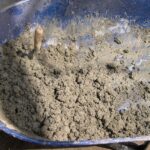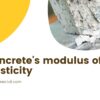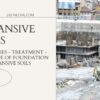Workability of concrete is one of many other factors because of which concrete outperforms other construction materials with affordability, versatility, strength, and durability as other handy aspects. So this read shed light on what is workability of concrete? why is it important? what are the factors effecting it? and how we can improve it to match requirements of any civil engineering project?
Do you know! The most common construction materials in civil engineering are – concrete, wood / timber, steel, bricks, stone, blocks, sand, clay. I’ve placed concrete at the first because it is the most common construction material in civil engineering projects.
The article is going to be a lengthy piece so take a mug of coffee and be prepared to read 2000+ words.
What is workability of Concrete?
The word “workability” defines an amalgam and composite of four concrete flow-making physical properties like mixability, transportability, mouldability, and compatibility.
You can’t ignore this physical parameter because of the fact that it effects the strength, durability, cost of labor, compaction effort, and also the final appearance.
Workability is more of a parameter that shows the ease of working with concrete while consistency is actually how wet the concrete is.
A workable concrete is defined as a concrete that can be readily placed and homogenously compacted without having any sort of bleeding or segregation. So workability can be defined as:
The characteristics of freshly mixed concrete or mortar because of which it can be hauled, poured, compacted, and finished with ease and homogeneity so there would be no bleeding or segregation.

Difference between workability and consistency
The word consistency is more used for cement rather than concrete while workability is used for concrete quite often. You might already know about the consistency test of cement by Vicat’s apparatus. So, if someone refers to as workability of cement he/she would be referring to the consistency of fresh cement rather than workability.
Likewise, the workability of cement is defined as the percentage of water required for the cement paste to be viscous and workable. If you’re working with cement paste, it is important that you defines the consistency or amount of water in cement because that would affect the setting time of cement paste.
Important to Note: In this test the consistency is defined of a cement past that permit the vicat plunger to penetrate to a point of 5 to 7 mm from the bottom of the vicat mould.
Likewise, the ability of the fresh concrete to flow is measured as consistency.
Consistency is actually a component of workability which refers to the way of the wetness of the concrete. We need a consistent concrete that can placed and compacted easily and have its cohesiveness and plasticity.
Workability is more of a parameter that shows the ease of working with concrete while consistency is actually how wet the concrete is.
Also Read: Difference between Segregation and Bleeding in Concrete
This brings in to a paint where we must know the segregation concrete definition.
Because the concrete is composed of different components, segregation in concrete is a point when solid particles tend to separate due to difference in sizes, density, and shape.
A typical segregated concrete is that in which fine and coarse aggregates are not properly mixed with cement slurry. You may love a consistent concrete but you’d hate a segregated concrete.
More of wet concrete is not always workable – because of segregation you can’t work yourself through the concrete.
Following are some of the factors effecting the segregation of concrete:
- height of fall during pouring – the more the height of fall, more are the chances of segregation. The recommended height of fall during concrete pouring is 3 to 5 ft as per the building code. You can use a chute or a hose pipe to reduce this height of fall.
- larger poroportion of large or coarser particles : this means the coarse particles are more and they’d fall more instead of with cement or fine particles.
- high specific gravity of coarse aggregates – same as above.
- lower amount of fine aggregate or sand – same behavior as above.
- particle shape and texture – Flaky or elongated aggregates cause segregation.
- water/cement ratio – more the w/c ratio more are the chances of segregation.
Workability and strength relationship
Now that you’ve got the basic knowledge of meaning of concrete workability, let’s move on to our next section which is about its relationship with strength.
As most common way of increasing workability is to add more water or in other words increase water cement ratio. So, increasing water cement ratio reduces the compressive strength of the concrete.
Unfortunately, concrete doesn’t possess the behavior of soil where adding more water increases the density of concrete. Thus, we can say the strength of concrete is inversely proportional to the workability of concrete.The strength of concrete is inversely proportional to the workability of concrete
Strength of concrete is actually its ability to take load either direct, bending or shear without breaking in the designated factor of safety. Now what happens when we add more water in the concrete. The concrete particles get lubricated and hydraulic film around the particle grow in size. The voids get fully saturated and after evaporation of water it leaves behind empty spaces or voids which reduces the compressive strength of the concrete. Hence, it is important to balance the strength and workability of the concrete to get the required quality of concrete.
In cases where you actually have to reduce water cement ratio for strength purpose than you can enhance workability by using rounded aggregates of workability enhancing admixtures. Air-entraining agents are a perfect example that increases the workability of concrete without increasing water cement ratio.
Effect of Properties of aggregate on workability of concrete
Aggregates accounts for 60 to 80 percent of the volume and 70 to 80 percent of the weight of concrete. The composition, size, surface texture, grading, and shape of aggregate have significant impact on workability of concrete.
The surface texture of aggregates affects the properties of fresh concrete. Smooth and rounded aggregates produce more workable concrete mix as compared with rough angular or elongated aggregate. Rough aggregates with sharp corners tend to interfere with each other as the concrete flows. But rough surface aggregates generate a stronger bond between the paste and the aggregate creating a higher strength.
The size and gradation affects the packing of aggregate particles and requirement of cement paste. When the particles of aggregate are of uniform size, the spacing is greatest require more cement past to fill voids and thus more will be the workability. But if the aggregates are well-graded and range of sizes are used, the lower amount of cement paste would be required and less would be the workability.
Important to Note: Actually the aggregate particles would be too dense, the cement paste cannot coat the particles having uniformly and workability will be poor.
But here cost is a major concern, because cement is the most expensive component. So a compromise and a tradeoff should be made between workability and economy. According to a research, the angularity of coarse aggregates has a greater impact on workability rather than changes in flakiness. By increasing the angularity there is reduction in the workability of concrete.
Types of Workability
When we say “types of workability” we actually mean the type of concrete with different amount of workability. So, basically there’re three different types of workability concretes:
- Unworkable concrete: It is never recommended for construction because of difficulty in handling and problems like segregation. Unworkable concrete is sometimes also referred as harsh concrete owing to the fact that hand mixing is not easy.
- Medium Workability concrete: For structures involving light reinforcement i.e. rebars do have much spacing, we use medium workability concrete. It works well on generally all types of common concrete construction works. It is relatively easy to mix, transport, and compact without having any adverse effects of segregation and loss of homogeneity.
- High workability: For heavy reinforced structures or for construction where compaction is difficult high workable concretes are used. Although, it is much easier to transport, mix, place, and compact but there are elevated chances of segregation and loss of homogeneity.
Effect of Temperature on workability of concrete
By temperature we mean the temperature of placing and compaction not that of batching. Anyhow, temperature has negative effects on the all the properties of concrete including workability. When the overall temperature of concrete increases, the workability of fresh concrete decreases in same proportion.
In normal Portland cement concrete i.e concrete without any chemical admixtures, the effect of temperature on workability of concrete is connected with cement hydration process. As a result of increase in temperature, there is considerable water loss due to evaporation which speeds up the cement hydration process. So, as concrete gets stiff earlier the workability of concrete is reduced abruptly.

Effect of time on workability of concrete
The time has same impact on workability of concrete, as is of the temperature. It is without a doubt that the concrete matrix gets stiffened with the passage of time, as a result of hydration reaction. The effect of time on workability is actually linked with the fluidity of concrete.
By fluidity we mean the amount of water available in the concrete for the hydration of cement compounds for the sake of bonding. With the passage of time and as a result of hydration reaction, the fluidity decreases as some water is utilized by cement hydration, some is absorbed by aggregated while a portion is lost in evaporation.
It is pertinent to mention, that the loss of workability by time depends on factors like property of cement (alkali content & sulphate content), moisture content of aggregate, and initial workability.
Effect of Vibration
It is useless to state that vibration has a positive effect on the workability of concrete. Infact, it is the most commonly used method to compact the concrete because of enhanced workability.
During placement of concrete, the vibrators of various sizes are immersed in the fresh concrete which liquefies the concrete matrix by reducing the internal friction between cement and aggregate allowing the mix to move around easily.
Interesting: According to a study by G.H> Tattersall & P.H. Baker, the concrete materials behave like a Newtonian liquid under vibration and at low shear rates.
Effect of Mix Proportion
By mix proportion of concrete mix design, we refer to any ingredients that have negative or positive effect on the workability of concrete. The water-cement ratio is very important mix proportion factor that affects the workability of concrete. As explained prior, the quantity of water and cement has to be adjusted during trial mix to get to a point where we can get maximum workability of concrete.
Effect of Water content or Water cement ratio on workability of concrete
The workability of concrete does increases with increase in water cement ratio but up to a limit. After that the concrete can bleed and there are chances of segregation in concrete mixture. Actually whenever someone talks about ways to increase workability – the first thing that clicks in mind is to add more water.
Adding water actually increases the inter-particle lubrication by reducing friction and thus we have higher fluidity. More water also results in higher concrete porosity and reduced strength.
Although increasing the workability can solve the problem of difficulty in compaction but there are elevated chances of bleeding and lose of compressive strength. So it is important to balance the factors and an optimum water-cement ratio should be maintained to get a workable concrete which have strength at the same time.
Importance of Workability of Concrete
Workability of concrete is a very important quality control parameter which should never be ignored at site. Infact, there are many other subsidiary factors that effects or are linked with the workability.
Workability is important for fresh concrete so that it can be easily placed and compacted in the formwork or in order to use by a concrete pump.
Requirements – How much should be the workability of concrete?
Well, this entirely depends on the size and type of the formwork used for the concrete element. It also depends on the concrete placement and type of structure.
For mass concrete structures like dam where roller compacted concrete is used, low workable concretes or concretes with hard slump are recommended. In contrast, for structures involving heavy reinforced members or thin members, high workable concretes are recommended.
Measurement of Workability of concrete or tests for workability of concrete
Workability of fresh concrete paste is measured by three common tests :
- Slump test
- Vee-bee test
- Compaction Factor test
Among all three, the most common and effective one is the slump test. It is field test while the other two i.e. vee-bee test and compaction factor test are laboratory tests. In slump test, the concrete paste is placed in standard mould called slump cone in 3 layers with each layer compacted by tamping with 25 blows of tamping rod. After that immediately, the mould is removed in vertical direction and the subsidence of concrete in workability is the slump of concrete.

Recommended values of slump for different concrete structures is as follows:
- Road construction – 20 to 40 mm
- Canal lining – 70 to 80 mm
- Mass concrete – 20 to 50 mm
- Concrete for walls, slabs, parapets, piers – 40 to 50 mm.
- Normal RCC work – 80 to 150 mm
How to increase workability of concrete?
The field engineers are always looking for how to improve the workability of concrete. Now that you’re well aware of all the factors that effects the workability of the concrete, it’s the time to find out how actually we can improve the workability of concrete.
These days, the most common method is the use of chemical admixtures. The use of pozzolanic materials like slag has better effects on workability of concrete. But, the positives of using air entraining agents are matchless. Along with admixtures, you can increase water/cement ratio or increase the size of the aggregates to get more workable concrete paste.
But all this depends on the type of structure and particular requirement of the concrete performance.
Further Read: Learn more about fineness of cement and how it impacts workability of concrete. Fineness of cement
Frequently Asked Questions
Here’s the summary:
- The concrete is said to be workable if: The concrete can be easily mixed, placed, consolidated, and compacted without any loss of homogeneity or segregation. Workability is there if the concrete is stable, moveable, and compatible.
- What do you mean by workability of concrete? – The ability of concrete with which the site persons can mix it, compact it, and place it easily without any trouble.
- What is unworkable concrete? A harsh or unworkable concrete is that which has too little or too much water in it. This means it is difficult to make a homogeneous mass of concrete with such a paste.
- Why workability of concrete is important? In order to make a concrete structure we need a concrete mix that can be placed easily within the formwork of any shape or size and can be compacted there with different methods. An unworkable or poorly workable concrete cannot easily take the desired shape of structure.
- Workability of concrete is inversely proportional to: the time of transit. That means,when the concrete is batched in the batching plant and is poured in the transit mixer to take it to the location of pouring, the setting reaction of concrete starts immediately. So, if the transit time is more the workability will be reduced as the cement reaction of hydration will lowers the workability.


















